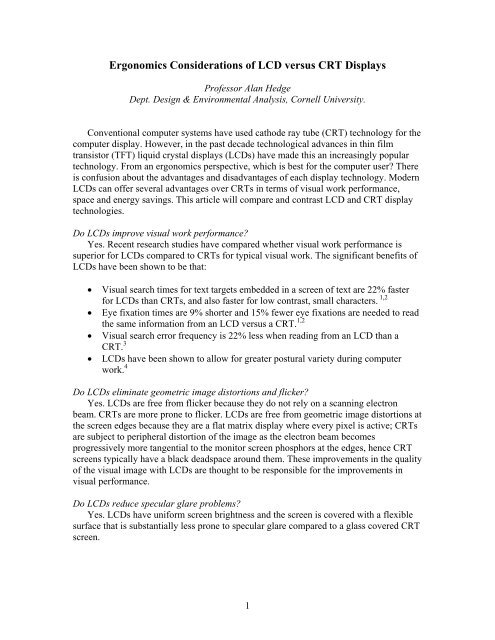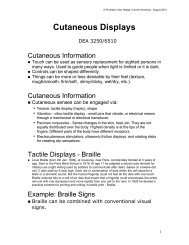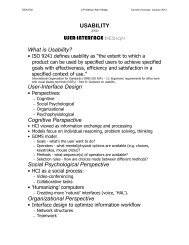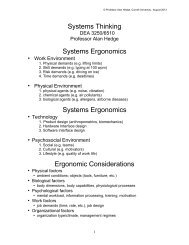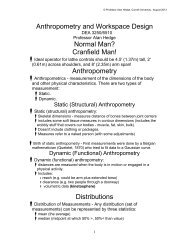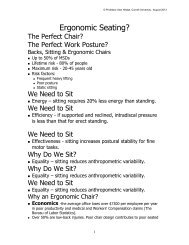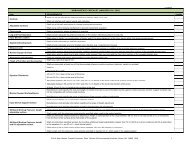LCD versus CRT - Cornell University Ergonomics Web
LCD versus CRT - Cornell University Ergonomics Web
LCD versus CRT - Cornell University Ergonomics Web
You also want an ePaper? Increase the reach of your titles
YUMPU automatically turns print PDFs into web optimized ePapers that Google loves.
<strong>Ergonomics</strong> Considerations of <strong>LCD</strong> <strong>versus</strong> <strong>CRT</strong> Displays<br />
Professor Alan Hedge<br />
Dept. Design & Environmental Analysis, <strong>Cornell</strong> <strong>University</strong>.<br />
Conventional computer systems have used cathode ray tube (<strong>CRT</strong>) technology for the<br />
computer display. However, in the past decade technological advances in thin film<br />
transistor (TFT) liquid crystal displays (<strong>LCD</strong>s) have made this an increasingly popular<br />
technology. From an ergonomics perspective, which is best for the computer user There<br />
is confusion about the advantages and disadvantages of each display technology. Modern<br />
<strong>LCD</strong>s can offer several advantages over <strong>CRT</strong>s in terms of visual work performance,<br />
space and energy savings. This article will compare and contrast <strong>LCD</strong> and <strong>CRT</strong> display<br />
technologies.<br />
Do <strong>LCD</strong>s improve visual work performance<br />
Yes. Recent research studies have compared whether visual work performance is<br />
superior for <strong>LCD</strong>s compared to <strong>CRT</strong>s for typical visual work. The significant benefits of<br />
<strong>LCD</strong>s have been shown to be that:<br />
• Visual search times for text targets embedded in a screen of text are 22% faster<br />
for <strong>LCD</strong>s than <strong>CRT</strong>s, and also faster for low contrast, small characters. 1,2<br />
• Eye fixation times are 9% shorter and 15% fewer eye fixations are needed to read<br />
the same information from an <strong>LCD</strong> <strong>versus</strong> a <strong>CRT</strong>. 1,2<br />
• Visual search error frequency is 22% less when reading from an <strong>LCD</strong> than a<br />
<strong>CRT</strong>. 3<br />
• <strong>LCD</strong>s have been shown to allow for greater postural variety during computer<br />
work. 4<br />
Do <strong>LCD</strong>s eliminate geometric image distortions and flicker<br />
Yes. <strong>LCD</strong>s are free from flicker because they do not rely on a scanning electron<br />
beam. <strong>CRT</strong>s are more prone to flicker. <strong>LCD</strong>s are free from geometric image distortions at<br />
the screen edges because they are a flat matrix display where every pixel is active; <strong>CRT</strong>s<br />
are subject to peripheral distortion of the image as the electron beam becomes<br />
progressively more tangential to the monitor screen phosphors at the edges, hence <strong>CRT</strong><br />
screens typically have a black deadspace around them. These improvements in the quality<br />
of the visual image with <strong>LCD</strong>s are thought to be responsible for the improvements in<br />
visual performance.<br />
Do <strong>LCD</strong>s reduce specular glare problems<br />
Yes. <strong>LCD</strong>s have uniform screen brightness and the screen is covered with a flexible<br />
surface that is substantially less prone to specular glare compared to a glass covered <strong>CRT</strong><br />
screen.<br />
1
Do <strong>LCD</strong>s reduce Computer Vision Syndrome<br />
Yes. <strong>LCD</strong>s are flicker free, which should reduce the risks of headaches, and the<br />
reductions in occulomotor effort (number of fixations) and the reductions in specular<br />
glare problems with <strong>LCD</strong>s should reduce complaints of eyestrain. However, additional<br />
research is required to confirm these predict benefits.<br />
Do <strong>LCD</strong>s save space<br />
Yes. An <strong>LCD</strong> display is much thinner and lighter than a <strong>CRT</strong> display of the<br />
equivalent viewing area. An <strong>LCD</strong> occupies substantially less space than a <strong>CRT</strong> (an <strong>LCD</strong><br />
is usually
Do <strong>LCD</strong>s emit VLF/ELF electromagnetic radiation<br />
No. Unlike <strong>CRT</strong>s, <strong>LCD</strong>s are free from VLF/ELF electromagnetic radiation emissions<br />
associated with the scanning electron beam required for a <strong>CRT</strong>.<br />
Do <strong>LCD</strong>s display similar colors and video<br />
For most office tasks the color and video quality of both <strong>LCD</strong>s and <strong>CRT</strong>s will be<br />
equivalent. For high end color graphics, <strong>CRT</strong>s can offer some advantages because <strong>LCD</strong>s<br />
can only display the colors available in the pixels, and so they can have less of a color<br />
depth than <strong>CRT</strong>s. Some <strong>LCD</strong>s (low cost, low resolution) have pixels that respond too<br />
slowly for accurate video rendering, and some tearing of the video image can occur,<br />
which usually is not an issue for <strong>CRT</strong>s.<br />
The considerations for each display technology are summarized below:<br />
Consideration <strong>LCD</strong> <strong>CRT</strong><br />
Visual performance Faster than <strong>CRT</strong> Slower than <strong>LCD</strong><br />
Image flicker None Prone to flicker<br />
Image brightness Bright, uniform Variable, uneven<br />
Image geometry Uniform Distorted<br />
Image sharpness High Moderate to high<br />
Screen viewing area Full area, very space efficient Partial area, space inefficient.<br />
Screen size<br />
Smaller screen for equivalent<br />
<strong>CRT</strong> viewing area<br />
Larger screen for equivalent <strong>LCD</strong><br />
viewing area<br />
Specular screen glare None Prone to specular glare<br />
Energy consumption Low High<br />
Electromagnetic emissions No Yes<br />
Heat emissions Minimal High<br />
Space efficiency High Low<br />
Flexible positioning Highly Moderate<br />
Weight Light Heavy<br />
Color range Very Good Excellent<br />
Cost Moderate Low<br />
References<br />
1. Ziefle, M. (2001) Aging, Visual Performance and Eyestrain in Different Screen Technologies,<br />
Proceedings of the Human Factors and <strong>Ergonomics</strong> Society 45th Annual Meeting, Volume 1,<br />
Minneapolis/St Paul, Minnesota, October 8-12, 2001. The Human Factors and <strong>Ergonomics</strong><br />
Society, Santa Monica, California, Pages: 262-266.<br />
2. Naesaenen, R.; Karlsson, J.; and Ojanpaeae, H. (2001) Display quality and the speed of visual<br />
letter search, Displays; 22(4): 107-113.<br />
3. Menozzi, M., Lang, F., Naepflin, U., Zeller, C. and Krueger, H. (2001) <strong>CRT</strong> <strong>versus</strong> <strong>LCD</strong>: Effects<br />
of refresh rate, display technology and background luminance in visual performance. Displays,<br />
22(3): 79-85.<br />
4. Nylen, P. (2002) Comparison of Stationary <strong>LCD</strong> and <strong>CRT</strong> Screens - Some Visual and<br />
Musculoskeletal Aspects WWDU 2002 - World Wide Work. Proceedings of the 6th International<br />
Scientific Conference on Work with Display Units, Edited by H. Luczak, A.E. Cakir and G. Cakir.<br />
ERGONOMIC Institut fur Arbeits- und Sozialforschung, Forschungsgesellschaft mbH, Berlin.<br />
Pages: 682-684.<br />
5. KSBA (1998) Flat panel monitors: “Expensive” technology that saves money, SCOpe, 3 (1),<br />
6. <strong>LCD</strong> vs <strong>CRT</strong>: Reasons to choose a flat panel monitor, http://www.empower.gb.com<br />
7. Energy savings of <strong>LCD</strong>s, http://home.jeita.or.jp/device/lirec/english/enviro/contribut.htm<br />
© Professor Alan Hedge, <strong>Cornell</strong> <strong>University</strong>, May, 2003.<br />
3


